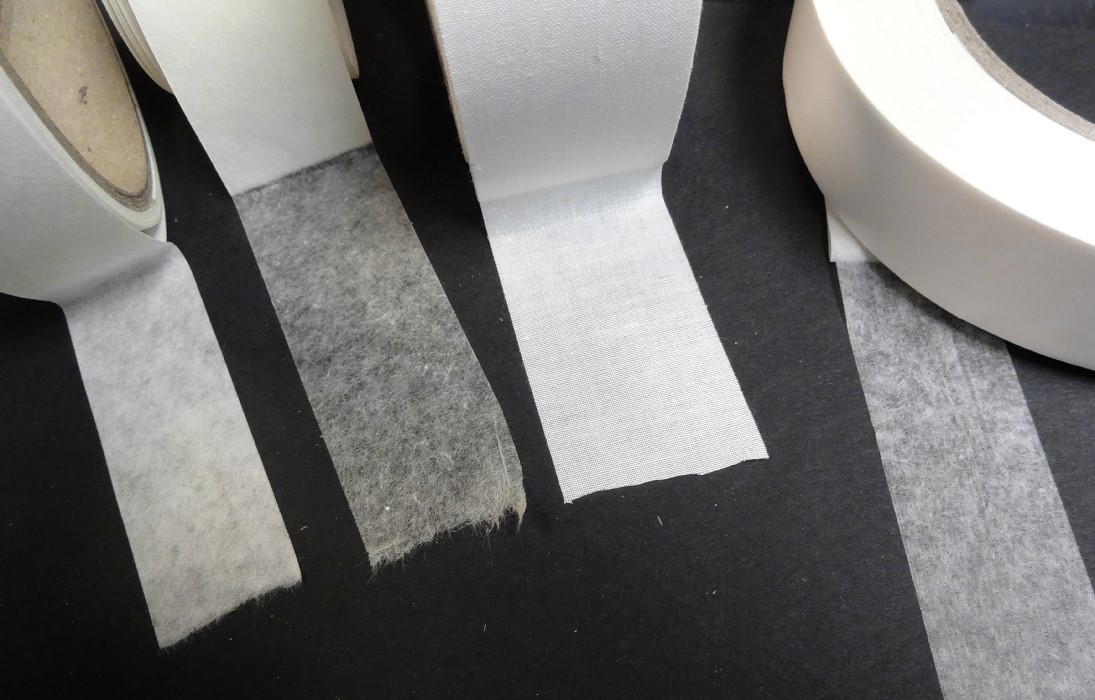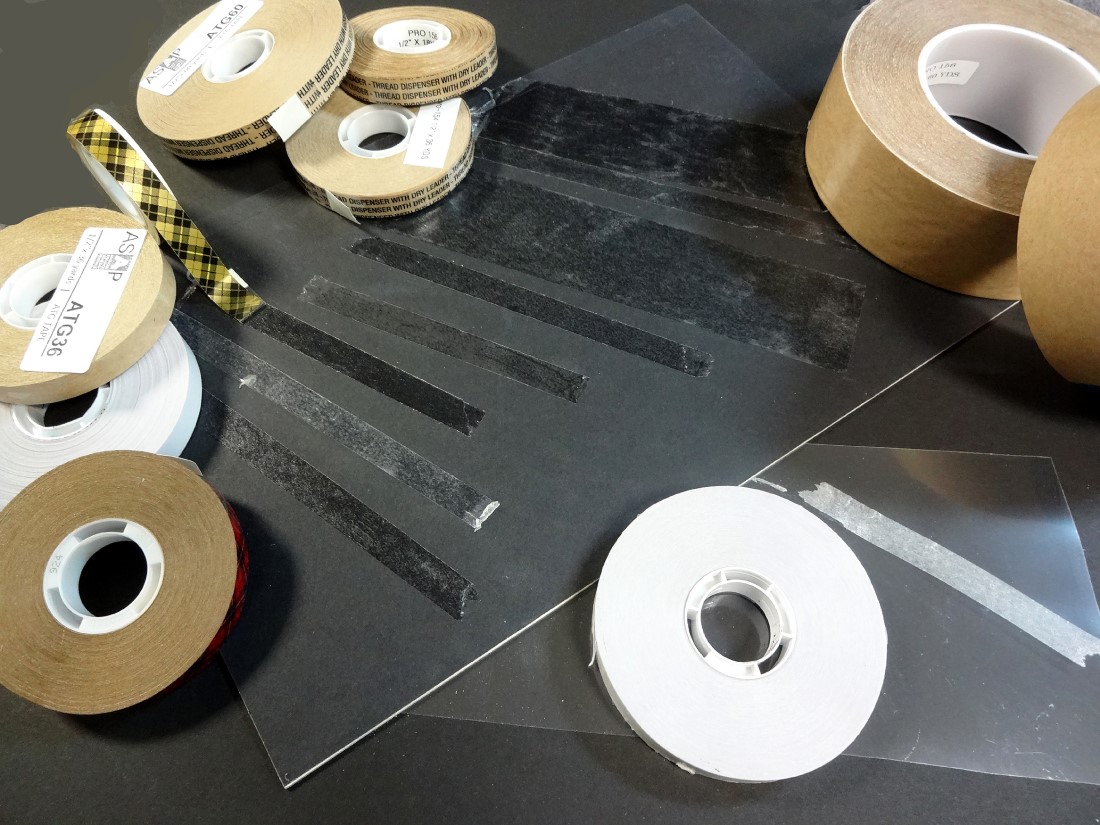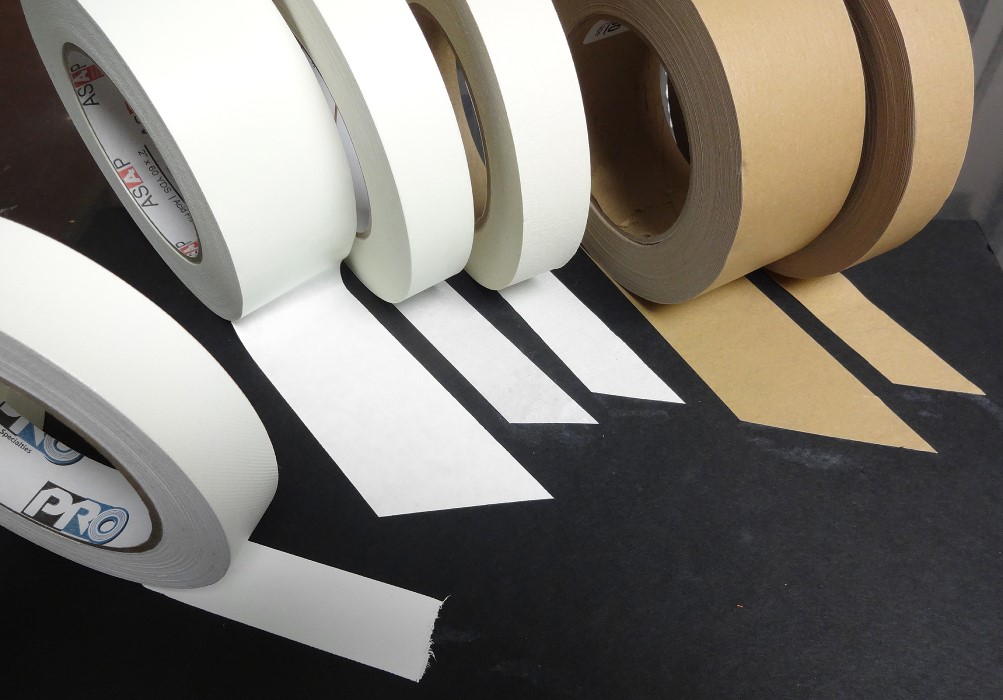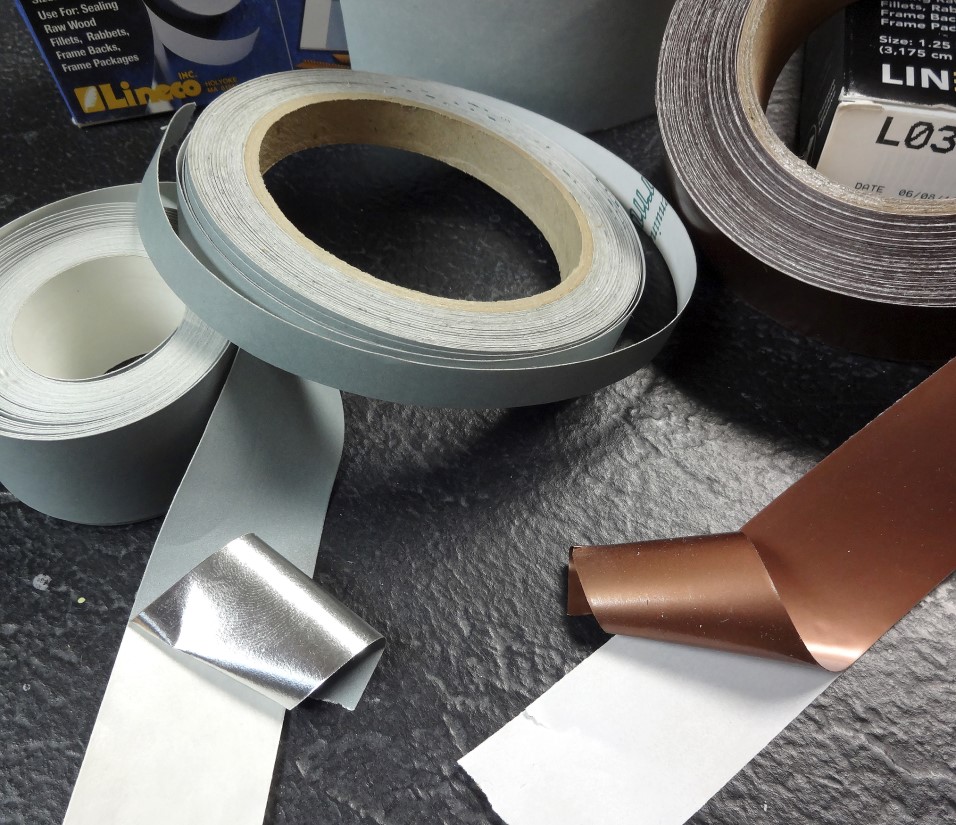 Photo 1
Photo 1
Hinging PSA tapes (L) Lineco Abaca-sa, Hinging tissue, Linen, (R) ASAP Hinging Tape.
Pressure-sensitive tape consists of a PSA coated onto a carrier such as paper, plastic film, cloth, or metal foil and may have a release liner backing to cover the adhesive until use which differs from every other category of adhesive as they do not require open time, heat activation or solvent evaporation in preparation for bonding. Permanent PSAs may be initially removable but build adhesion to a permanent bond once cured after several hours or days, disallowing removal without substrate damage. Removable (releasable) PSAs are designed to form a temporary bond and may be removed without harming the substrate or leaving adhesive residue. Removable adhesives are used for masking tapes, pricing labels and promotional graphics materials.
NR, SA, and Acrylic PSAs
There are three primary groups of adhesives used in PSA production. These three groups are natural rubber adhesives, synthetic rubber adhesives, and acrylic adhesives. Within these groups, there are countless variations and distinctive features making it difficult to predict the exact performance of an adhesive simply by knowing the type of adhesive. There are specific characteristics that are typical of each type that will help make the correct choice.
Natural Rubber (NR) Adhesives
Tackifier resins are always added to NR to create a PSA. The type of rubber used, the compounded resins, and other ingredients determine the performance of the adhesive offering high initial tack and grab; excellent peel adhesion; short dwell time to final adhesion; and clean removal after application (masking tape). NR adhesives do have disadvantages including poor cohesion at higher temperatures; poor aging resistance; low resistance to UV, ozone; and poor chemical and solvent resistance making them best for non-permanent, indoor applications.
Synthetic Rubber (SR) Adhesives
Tackifier resins are also added to SR for PSAs. Adhesives are high initial tack; very high initial bond; excellent peel adhesion; and are low cost. Disadvantages include low resistance to elevated temperatures; poor aging resistance, but better than natural rubber; low environmental resistance against UV, ozone; and moderate solvent resistance.
Acrylic Adhesives
Adhesive properties of acrylic can be adjusted and controlled by manipulating the formulation and the polymerization process. In contradiction to NR and SR adhesives, acrylic adhesives are tacky by nature. Acrylic adhesives have long polymer chains that are cross-linked placing acrylic adhesives in a much higher performance category. Acrylic advantages are transparency; resistance to yellowing, high-temperature, UV, ozone, moisture, solvents, plasticizers; and have very good peel adhesion. Adding tackifier resins improves peel adhesion and/or reduces dwell time making these best for long-term and outdoor applications.
Application and Tack
Downward pressure and a quick rub used to adhere a pressure-sensitive tape only activates about 25% of the adhesive. Firmly rubbing the strip with a bone burnisher will activate nearly 80% of the adhesive, then weighting during cure will allow for maximum fusion. High tack PSA is the most aggressive and more difficult to apply manually than medium or low tack because of its immediate grab and lack of repositioning potential. It aggressively bonds to a smooth nonporous or coated stock—like photos—and is most often best applied with roller machines.
Medium tack PSA has been the type most used in framing, and is available as immediate tack and repositionable until burnished. The benefit of having a repositionable tape is peace of mind, but the trade-off is loss of a longer term more aggressive bond. Repositionable adhesive is somewhat forgiving during mounting with porous papers, but even repositionable adhesive will grab more aggressively to a smooth or coated material. Low tack PSA is a very temporary, nonaggressive bond that is not suitable for the longevity that framing demands. It is best used as a temporary positioning tack in preparation for other bonding as with 3M 811.
Pressure-Sensitive Tapes
Lineco offers a series of tapes including Abaca.sa, incorporating the strength of Abaca Manila hemp paper with strong acrylic adhesive that is non-yellowing, acid free, biodegradable, and permanent. Lineco Mounting/Hinging Tissue is a permanent, long fibered tissue with acrylic adhesive for hinging translucent art requiring mineral spirits for removal. ASAP Tissue Hinging Tape S-A is also for hinging thin or semi transparent art. ASAP Acid Free Hinging Tape is a repositionable SR on tissue carrier, neutral pH, leaving no residue when removed, 1" and 2". (photo 1)
 Photo 1
Photo 1
Hinging PSA tapes (L) Lineco Abaca-sa, Hinging tissue, Linen, (R) ASAP Hinging Tape.
Lineco S-A Cloth Hinging Tape is a linen tape for window mats to backboard with a neutral pH, acrylic adhesive, available in three colors and several widths. ASAP Linen Tape S-A is an extra strong linen material coated with a neutral ph adhesive for hinging window mats to mounting boards. ASAP Acid Free Strong Tape is an aggressive non-repositionable, solvent base acrylic on tissue carrier for hinging mats and dust covers. PRO Framers is a white, neutral pH, non-staining, permanent, polyethylene coated cloth synthetic rubber adhesive tape for seaming, sealing, and splicing. (photo 2)
 Photo 2
Photo 2
(L-R) PRO Framers, ASAP AF Hinging Tape " and 1", ASAP Art Tape, ASAP Kraft Tape 2" and 1".
ATG
ATG is a clear, non-carrier PSA commonly used in framing, developed for and named after, adhesive transfer guns (ATG). The tape is a non-carrier film sandwiched between removable layers of a double-sided coated release liner. ASAP Double Sided ATG is a clear, permanent, acrylic for dust covers and matting. PRO 154 ATG 2 mil acrylic for guns; PRO 155 ATG is a high-tack, 2 mil, permanent acrylic; PRO 156 is a 5 mil, clear ATG for foam, fabrics, metal, and plastic. PRO 410 ATG is a neutral pH solvent based acrylic resistant to UV, high temperatures, and plasticizers. (photo 3)
 Photo 3
Photo 3
ATG tape sample strips (bottom to top) Scotch 924, ASAP Strong ATG, Scotch AF 908, ASAP ATG, PRO Tapes 154, Pro Tapes 155 ½" and 2", PRP Tapes 156 high tack ½" and 2" all applied to matboard, and PRO Strong Acid Free ATG on polyester sheet (R).
Scotch 924 is a medium-firm acrylic adhesive with quick stick adhesion and shear strength for bonding metal, glass, wood, paper and plastic. Scotch 926 is a firm high tack acrylic with very high adhesion, shear strength, high temperature and UV resistance. Scotch 969 is a soft acrylic PSA with high initial adhesion and good shear holding power to a wide variety of materials including most plastics. Scotch Gold AF 908 is a medium firm, permanent, acrylic, pH 7.0-8.5, that meets PAT requirements.
Special Tapes
Lineco Sealing Tape is a gray paper carrier backed with foil that is a non-yellowing, permanent acrylic P-S adhesive which attaches firmly to almost any surface and conforms well to surface irregularities providing a barrier for the rabbets, fillets. Lineco I-Film Frame Sealing Tape is a strong acrylic, acid free, puncture resistant, polyethylene barrier that blocks acid, corrosive gases, mold and mildew. ASAP Fillet Tape is an aggressive double-sided, non-yellowing polyester tape for a barrier to protect artwork from acid burn of wood fillets. (photo 4)
 Photo 4
Photo 4
Lineco Sealing Tape 2" and ½" aluminum backed (L), and I-Film Frame Sealing Tape (R) 1½" polyethylene with Corrosion Intercept®.
ASAP Mirror Tape has a thin smooth, matte finish with pH 7.1 for lining a frame rabbet when fitting a mirror to prevent reflection. ASAP Double Sided Foam Tape is a white crossed linked polyethylene foam tape, double coated with a solvent base acrylic PSA on a red polyethylene release liner for mounting fabric to metal.
Afterthoughts
P-S tapes should never be used in conjunction with the hinging or mounting of any original or irreplaceable fine art or photo regardless of whether they are acid free or not. Be careful when selecting tapes for framing, as damage may occur from P-S adhesives over time. Pay attention to what the adhesive is made of, its permanence and suggested uses. Not all tapes developed for framing may be used for hinging and acid free could be mean either the adhesive or the carrier. Even water soluble brands only remove the tissue carrier and not adhesive saturation that may have occurred. And after about ten years of application self-adhesive tape will chemically react and cross-link with atmospheric pollutants rendering the new adhesive substance insoluble and non-removable.
END
Copyright © 2017 Chris A Paschke
For more articles on mounting basics look under the mounting section in Articles by Subject.
Additional information on all types of mounting is found in:
The Mounting and Laminating Handbook, Second Edition, 2002,
The Mounting And Laminating Handbook, Third Edition, 2008 and
Creative Mounting, Wrapping, And Laminating, 2000 will teach you everything you need to know about getting the most from your dry mount equipment and materials as an innovative frame designer.
All books are available from Designs Ink Publishing through this website.
Chris A Paschke, CPF GCF
Designs Ink
Designs Ink Publishing
785 Tucker Road, Suite G-183
Tehachapi, CA 93561
P 661-821-2188
chris@designsinkart.com